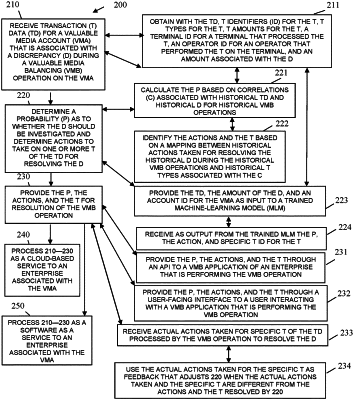| CPC G06Q 40/125 (2013.12) [G06N 20/00 (2019.01); G07D 11/36 (2019.01)] | 6 Claims |

|
1. A method, comprising:
classifying historical cash balancing records for cash accounts into categories based on results taken for discrepancies with the cash accounts during cash balancing operations;
tagging first classified historical cash balancing records with first tags that identify historical reasons provided in the historical cash balancing records for being unable or unwilling to resolve or to reduce corresponding discrepancies;
tagging second classified historical cash balancing records with second tags that identify actions taken during corresponding cash balancing operations that resulted in resolutions or mitigations of corresponding discrepancies;
obtaining historical transaction data associated with the cash accounts and the historical cash balancing records, wherein the historical transaction data includes transaction details such as price, type of valuable media used, items purchased, customer identifier, transaction operator identifier, terminal or device identifiers, date and time stamps;
training a machine-learning model on an input that comprises account identifiers for the cash accounts, discrepancy amounts for the discrepancies, and the historical transaction data;
training the machine-learning model to produce an output comprising a probability that a particular cash account with a particular discrepancy can or should be resolved or mitigated along with recommended actions for specific transactions for resolving or mitigating the particular discrepancy based on the historical reasons that follow the first tags in the first classified historical cash balancing records and the actions taken that follow the second tags in the second classified historical cash balancing records when the machine-learning model is provided corresponding input;
processing the machine-learning model for the cash accounts during post-training cash balancing operations with current transaction data associated with the cash accounts and current discrepancy amounts associated with current discrepancies for the cash accounts to identify whether the current discrepancies should be investigated or resolved based on current probabilities provided by the machine-learning model and to identify current actions that should be taken on specific transactions to rectify or to mitigate the current discrepancies provided by the machine-learning model;
receiving actual actions taken for specific transactions of the current transaction data processed by a valuable media balancing operation to resolve the current discrepancies; and
using the actual actions taken for the specific transactions as feedback that adjusts determining when the actual actions taken and the specific transactions are different from the actions and the specific transactions resolved by determining, wherein the feedback is used to retrain the machine-learning model during a subsequent training session to continuously improve accuracy in identifying accounts that can and should be rectified and in proposing needed monetary actions and particular transactions to investigate when rectifying the discrepancies.
|